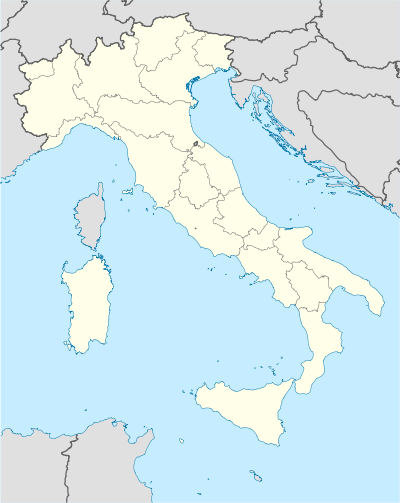Varese
| Varese | |
|---|---|
| — Comune — | |
| Comune di Varese | |
 |
|
 Varese
|
|
| Coordinates: | |
| Country | Italy |
| Region | Lombardy |
| Province | Varese (VA) |
| Frazioni | Avigno, Belforte, Biumo Inferiore, Biumo Superiore, Bizzozero, Bobbiate, Bosto, Bregazzana, Bustecche, Calcinate degli Orrigoni, Calcinate del Pesce, Campo dei Fiori, Capolago, Cartabbia, Casa Bassa, Casbeno, Cascina Gualtino, Cascina Mentasti, Caverzasio, Fogliaro, Gaggio, Giubiano, Lissago, Masnago, Mirasole, Mustonate, Oronco, Prima Cappella, Rasa di Varese, San Fermo, Sangallo, Santa Maria del Monte, Sant'Ambrogio, Schiranna, Ungheria, Velate |
| Government | |
| - Mayor | Attilio Fontana |
| Area | |
| - Total | 54 km2 (20.8 sq mi) |
| Elevation | 382 m (1,253 ft) |
| Population (31 January 2009) | |
| - Total | 81,922 |
| - Density | 1,517.1/km2 (3,929.2/sq mi) |
| Demonym | Varesini |
| Time zone | CET (UTC+1) |
| - Summer (DST) | CEST (UTC+2) |
| Postal code | 21100 |
| Dialing code | 0332 |
| Patron saint | San Vittore |
| Saint day | May 8 |
| Website | Official website |
Varese listen (pronounced [vaˈreze] in Italian; Baretium in Latin) is a town and comune in north-western Lombardy, northern Italy, 55 km north of Milan.
It is the capital of the Province of Varese. The hinterland or urban part of the city is called Varesotto.
Contents |
Geography
The town of Varese lies at the feet of Sacro Monte di Varese, which is part of the Campo dei Fiori mountain range. The town also looks over Lake Varese. While the province of Varese lies below the Alps, so mountains and hills constitute 32% and 46% of its territory respectively; other common features are rivers (including the Ticino and Olona) and seven lakes: three are big, (Lake Maggiore, Lake Lugano and Lake of Varese and four other smaller ones Lake of Comabbio, Lake of Monate, Lake of Ghirla and Lake of Ganna. The southern part of the province is in the Pianura Padana (the flat bottomland of the River Po).
Demographics
Varese, like the province, has a very high immigrant population owing to both its economy (many multi-national companies and the nearby EU institution JRC and location (proximity to Milan makes it an ideal place for the latter city's workers).
History
The town owes its origin to the strategic position that it held in past centuries: the two transapennine roads, toward Parma and Tortona, across the Pass of Cento Croci and Bocco, intersected here. The roads from the coast went through Varese territory and entered the Po Valley, so that a trading market developed in this territory. A Byzantine settlement, the ruins of which were found under the castle, existed in the Varese area of today.
The presence of the Lavagna Counts in Varese territory dates from the beginning of the 11th century, and in 1161 Emperor Federico I invested the family with the title.
At the end of the 12th century, two branches of Lavagna Counts - the Fieschi and Pinelli families - settled in Cassego from where they began to disforest, to build wooden constructions, to seed and breed livestock. The conflicts between the two families began immediately when the Fieschi family threw the Pinelli family out of Cassego and forced them to seek refuge in Carbello where they built a tower called “Pinelli Tower”. Later the two families agreed to divide up the territory.
However, as the Fieschi family came to power in the Upper Val di Vara in the end of 13th century, they consolidated their presence by founding a village that became the center of regional life, and drew up a settlement plan that provided for identical brick houses. The Fieschi family continued the feud until 1386, when Antoniotto Adorno, the Genoese Doge, bought Varese from Count Carlo.
In 1472 Varese was ruled by the Laudi family, feudatories of the Upper Val di Taro, until 1547 when, as result of a failed conspiracy of a nephew, GianLuigi, against Andrea Doria, the family power waned, and its dominions were expropriated to the Genoa Republic.
In 1859, Giuseppe Garibaldi confronted Austrian forces led by Field Marshal-Lieutenant Carl Baron Urban near Varese. Also, it was here were Alessandro Marchetti's Savoia-Marchetti SM.93 made his first test flights.
Transport
The town is served by both the state-run Ferrovie dello Stato (FS) and Ferrovie Nord Milano (Le Nord), both of which run high-frequency train services to Milan. In addition, there is a project under way to connect Varese with Malpensa Airport; this line would then continue past Varese to Mendrisio and Lugano in Switzerland. Construction of the Varese-Mendrisio section (17.7 kilometers (11 mi) long) is expected to begin in 2009.[1]
The town has both an extensive city bus network and provincial bus services. The A8 motorway connects Varese with Milan. This motorway was part of the first toll road system in the world. The Italian government gave permission in 2008 to start works on the long awaited Varese-Como-Bergamo motorway, which would also include a bypass of the town of Varese. Works are to start in 2010, and they might be finished by 2013.[2]
Main sights
The town is most famous for the Sacro Monte di Varese ('the sacred mountain of Varese'), a place of pilgrimage and worship. It is one of the Sacri Monti of Piedmont and Lombardy, included on the UNESCO World Heritage list.
Economy
The economy of Varese is mainly based on industry and, to a lesser extent, specialized agriculture; some famous Varese-based firms are:
- Aermacchi (military trainer aircraft)
- AgustaWestland (helicopters)
- Cagiva, MV Agusta (motorbikes)
- Ficep (Machine Tools for steel construction)
- Ignis (now part of Whirlpool) (electronics)
- Vibram
- Prealpi (cheese)
- Mazzuchelli
- DiVarese (Shoes)
and many more as it is one of the most industrialised areas in Northern Italy.
Varese is home to Malpensa International Airport, which serves the international traffic of Milan, Italy.
Education
Varese is home to a European School, the European School, Varese, which was established in 1960 for the children of European Union staff, who work mainly at one of the three Joint Research Centres in nearby Ispra.
It is one of the two sites of the University of Insubria.
Notable people associated with Varese
- Pietro Antonio Magatti (1691-1767), a painter active in Lombardy in a late-Baroque (barocchetto) style.
- Enrico Dandolo (1827–1849), a figure of the Italian Risorgimento who participated in several of its most important battles and participated in the formation of the Roman Republic.
- Emilio Dandolo (1830–1859), brother of Enrico, who also participated in several of the most important battles of the Risorgimento, including the Five Days of Milan uprising.
- Emilio Morosini (1830–1849), participant in the Risorgimento.
- Francesco Tamagno (1850-1905), a great operatic tenor and the creator of the role of Verdi's Otello, who lived at Varese and died at his villa there, aged 54.
- Alfredo Binda (1902–1986), a cyclist of the 1920s and 1930s, later trainer of Fausto Coppi and Gino Bartali.
- Flaminio Bertoni (1903–1964), a sculptor and industrial designer known especially for his work at Citroën where he designed the 2CV, the H van, the DS and the Ami 6.
- Franco Ossola (1921–1949), a member of the Torino F.C. squad who died in the Superga air disaster; Stadio Franco Ossola, the stadium of A.S. Varese 1910, is named in his honour.
- Giuseppe Zamberletti (born 1933), Italian politician recognised as the founding father of the modern Italian Department of Civil Protection.
- Attilio Nicora (born 1937), cardinal of the Roman Catholic Church]] and Emeritus Bishop of Verona.
- Bruno Ermolli (born 1939), businessman.
- Renato Pozzetto (born 1940), actor, director and cabaret artist and one of the best loved figures of Italian comedy in recent years.
- Umberto Bossi (born 1941), politician; leader of the Lega Lombarda, and of the Lega Nord; Minister for Institutional Reforms and Devolution and Minister of Federal Reforms.
- Mario Monti(born 1943), economist and politician; European Commissioner from 1995 to 2004.
- Aldo Ossola (born 1945), a former basketball player for the Ignis Varese team of the 1970s.
- Flavio Premoli(born 1949), an Italian musician and composer, a member of the Italian progressive rock band PFM.
- Dino Meneghin (born 1950), professional basketball player for Ignis Varese and silver medalist at the 1980 Summer Olympics.
- Roberto Maroni (born 1955), Italian politician, member of Lega Nord who served as Minister of the Interior and Minister of Labour and Welfare in various Berlusconi governments.
- Lilli Carati (born 1956), former model and pornographic actress.
- Catherine Nardiello (born 1958), Italian-American pianist, lived in Varese in the late 1980s.
- Francesco Vescovi known as “Cecco” (born 1964), a former basketball player who grew up in Varese.
- Ivan Basso (born 1977), professional cyclist and winner of the 2006 Giro d'Italia.
- Fabrizio Macchi known as “Cuky” (born 1970), an amputee cyclist and bronze medal winner at the 2004 Summer Paralympics.
- Daniele Nardello (born 1972), a professional road racing cyclist who rides for Serramenti PVC Diquigiovanni-Androni Giocattoli.
- Stefano Garzelli (born 1973), cyclist; overall winner of the 2000 Giro d'Italia.
- Andrea Meneghin (born 1974), basketball player and coach with Pallacanestro Varese; selected in the All-Eurobasket Team in 1999 when the Italian national team won the Gold medal.
- Laura Macchi (born 1979), basketball player whose career began at Pallacanestro Varese.
- Paride Grillo (born 1982), cyclist with CSF Group-Navigare.
Music festivals
Sport
Varese is known for the Pallacanestro Varese which played, in the 1970s, 10 European Champions Cup finals in a row and won 5 of them.
- A.S. Varese 1910 (football)
- A.S. Mastini Varese Hockey
- Pro Tennis Team Varese
- 2008 UCI Road World Championships
International relations
Twin towns — Sister cities
Varese is twinned with:
 Romans-sur-Isère, France
Romans-sur-Isère, France
External links
- History Art and Culture of Varese in the Italian Lakes
- Italian Lakes Photograph Gallery, Lake Varese Italian Lakes Photograph Gallery - Tourist Guide.
- Tourist information
- arci Varese, association for the promotion of social, Territorial Delegation
|
|||||||
